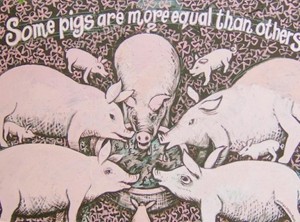 It’s my pleasure to unveil my newest product, NextGuide. NextGuide is a hyper-personalized TV listings guide designed specifically for the iPad™. It’s been a six month labor of lots and lots of love, and I’m extremely excited to tell you about it. In a nutshell? We went to the drawing board and utterly reinvented the concept of the TV program guide.
It’s my pleasure to unveil my newest product, NextGuide. NextGuide is a hyper-personalized TV listings guide designed specifically for the iPad™. It’s been a six month labor of lots and lots of love, and I’m extremely excited to tell you about it. In a nutshell? We went to the drawing board and utterly reinvented the concept of the TV program guide.
If you think about the concept of a “guide” it’s something that’s evolved over 60 years from supporting 3 to 13 to 80 to 500+ channels. But that’s really all it does, and let’s face it, we no longer live in a 500-channel world. We live in a 500 channel, plus tens of thousands of hours of streaming content on services like Netflix, huge libraries of video on demand from our cable and satellite companies, as well as iTunes itself. It’s effectively an infinite content landscape, and having so much content has crippled the formerly easy process of discovering shows to watch.
As an example, in my house at night, we start by browsing our DVR library, don’t see anything we’re in the mood for, then switch over to live TV. After browsing (painfully) the grid for a while, we give up, turn on the Apple TV, and head to Netflix. Netflix is great, but I have a tendency to see stuff I already know about – Mad Men, Dexter, Weeds, Breaking Bad, etc – all great shows, but not really anything new that I’m ready to consume. Part of the problem here is catch-up TV: if I’ve never watched Mad Men before then I’m a good 80+ hours away from catching up to live, and that sounds painful. Anyhow, after an unsuccessful attempt to find something to stream, I generally end up watching whatever’s on (either Cops, the Shawshank Redemption, or an infomercial), then go to sleep. Sound familiar at all?
So we invented NextGuide, designed to actually help me discover things I *want* to watch. We do that by tilting the concept of Channels, Times, and Genres on its head a little, and instead focus on Shows, People, and Interests.
Shows – we believe people care more about the show they watch than the channel number or time it airs. So NextGuide uses beautiful show cover art to make it easy to find things and “escape” the grid view of numbers and times.
People – we believe TV remains a central zeitgeist component to modern society. When was the last time you chatted with any friend about a show you like (or love)? Probably in the past day or so. NextGuide makes it ridiculously easy to turn conversations, not to mention Facebook Likes, into easily discoverable shows.
Interests – we believe people care about finding things of interest to them, personally. We all have interests, from bands to sports, from cities to hobbies, and these interests define so much of our lives. NextGuide connects you to your interests, and finds them all on TV and streaming services, in a seamless, organic way. Examples of what NextGuide’s found for me over the past few weeks: Bill Murray’s guest appearance on Letterman (seriously, how would I even have known that unless I watch every night??), a live Coldplay concert on Palladium (I didn’t even know the channel was in my lineup), and Bizarre Foods goes to San Francisco (not a show I normally care for, but had to see what Andrew found in my city).
That’s enough writing already, this is one of those apps you just have to experience to get a sense of what we’ve done. It’s a complete paradigm shift for TV viewing, and I’m happy to share it with you. You can download it from the App Store, or watch our quick intro video below.
Introducing NextGuide from Dijit Media on Vimeo.
I can’t wait for your feedback, thanks so much for trying out the app. Thanks to Apple for inventing the iPad so we could have such a cool platform to bring something like this to life. Extra special thanks to my family, friends, coworkers and investors who have made the process of inventing something disruptive more fun than I think I really deserve.
We are getting some amazing press so far today, here are some great pieces:
- TUAW – check out this quote: “Until Apple comes up with whatever groundbreaking interface for TV discovery it’s hiding in the labs, NextGuide is likely the next best thing.”
- Scobleizer (includes a great video)
- TechCrunch (also with video)
- Multichannel News
- Engadget
- Slashgear
- Gizmodo
- GigaOm
- TheStreet
- VentureBeat
Oh, and here’s the actual announcement on our newly revised site!
 So my
So my 
 A few weeks ago someone mocked up a concept MacBook touch, and in a nutshell,
A few weeks ago someone mocked up a concept MacBook touch, and in a nutshell, 



 I was thinking about a few of my “favorite” things, and while none are mittens, most are the things I own that are more scarce than the rest. The outdoor furniture my wife and I bought on our trip to Vietnam. The shirts I had custom made in South Korea. The t-shirts I order from CafePress are also fairly special to me, but no more so than the fridge magnets I pick up for my kids in every airport I visit. All are hard(er) to find. But the stuff I really like? The highly limited run shirts at Threadless – until I bump into someone with the same shirt on. Sad face. My favorite t-shirt is one I bought from a UK-based semi-custom t-shirt store (pictured to your right – feeling good Billie Ray!).
I was thinking about a few of my “favorite” things, and while none are mittens, most are the things I own that are more scarce than the rest. The outdoor furniture my wife and I bought on our trip to Vietnam. The shirts I had custom made in South Korea. The t-shirts I order from CafePress are also fairly special to me, but no more so than the fridge magnets I pick up for my kids in every airport I visit. All are hard(er) to find. But the stuff I really like? The highly limited run shirts at Threadless – until I bump into someone with the same shirt on. Sad face. My favorite t-shirt is one I bought from a UK-based semi-custom t-shirt store (pictured to your right – feeling good Billie Ray!).


